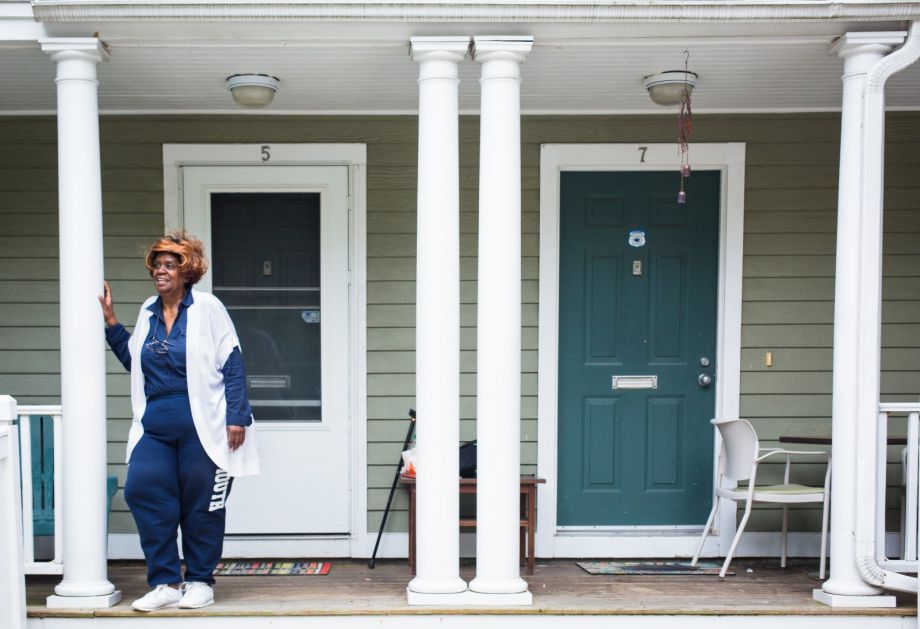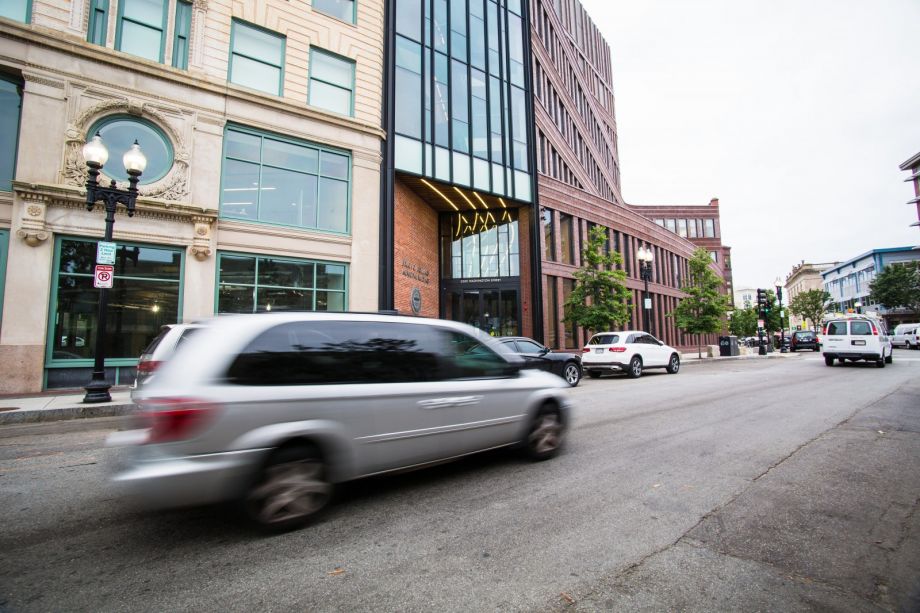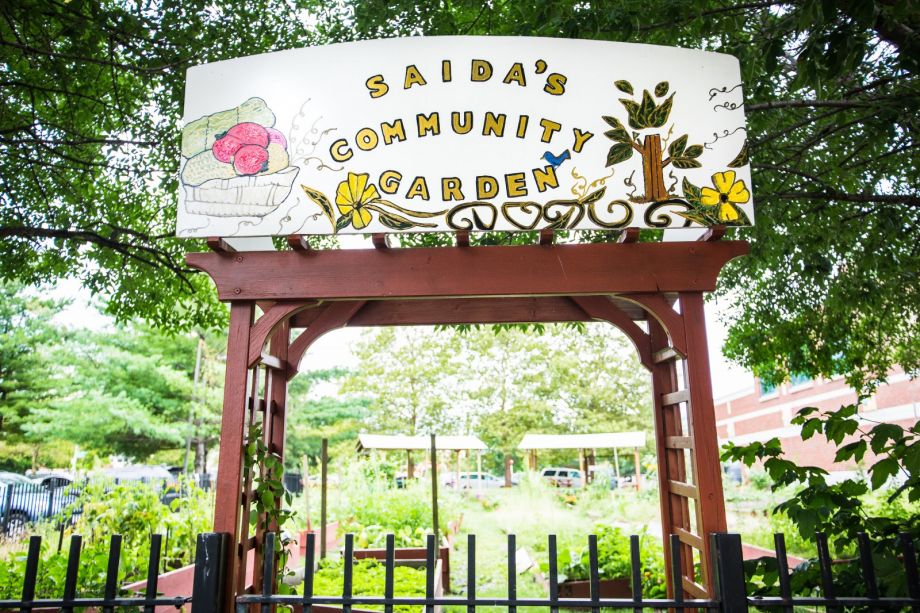Are You A Vanguard? Applications Now Open
This is your first of three free stories this month. Become a free or sustaining member to read unlimited articles, webinars and ebooks.
Become A MemberWhen Catherine Hardaway was a teenager in the late ’60s, she and her friends would take the bus to Boston’s Dudley Square and hang out at the rotisserie chicken restaurant and the hot dog stand. Dudley Square was like a second downtown back then, the center of the Roxbury neighborhood and Boston’s black community. As elevated trains rumbled into Dudley Station, shoppers bustled into and out of Ferdinand’s furniture store, with its baroque limestone facade, and the square’s clothing and shoe shops. At 16, Hardaway got a job at a Dudley Square accessories store, selling wallets and wigs. “You didn’t have to leave your community to find what you needed,” she recalls.
Since then, Hardaway has seen Dudley Square go nearly vacant, Ferdinand’s shuttered, the elevated rail dismantled. And she’s seen the square start to come back: Boston’s school district offices have moved into the old furniture building, the Silver Line rapid transit buses have given Dudley Station a next-best connection to downtown, and people stream in and out of the Dudley Cafe and other new lunch spots facing the square.
Hardaway, who now lives in Boston’s Mattapan neighborhood, has done her part to rebuild Dudley. As executive director of Central Boston Elder Services, she’s developed a 57-unit apartment building for seniors and an office that houses her 165 home-care employees. “I built that office building,” she says with understated pride. “Bringing our office there was like giving a shot in the arm to Dudley, to have more folks right there in the community who support the businesses.”
Now, Hardaway is impatient to see more growth in Dudley Square — more businesses, fewer vacancies. She wants it to look more like the main streets in Jamaica Plain and Hyde Park, Boston neighborhoods with more family-owned stores and restaurants. “It almost feels like everything around us is developing,” she says. “So much has happened in some other communities, yet Dudley is still so far behind.”
A few blocks away, Valerie Shelley fears the growth Hardaway awaits. The longtime Dudley Square resident looks at the many plans to build new housing nearby and thinks they’ll drive up rents across the neighborhood.
“They’ll price us out,” says Shelley. “It’s gentrification — that’s what’s happened in the South End. But if I have anything to do with it, I’m going to fight them all the way.”

Valerie Shelley stands in front of her Orchard Garden home.
Shelley, a former school board employee, is president of the tenants’ association in Orchard Gardens, an apartment complex built in 1999 on the former site of a public housing project. She doesn’t want Dudley Square to go the way of the neighboring South End, once a working-class part of town, where condominiums now sell for $800,000 or more.
“I don’t have a problem with the changes. Who doesn’t want a better community?” Shelley says. “But let’s not move us out. Don’t make it better on the backs of other people.”
In Boston, a fast-gentrifying city with a large black-white wealth gap, the wave of development is sweeping toward long-neglected Roxbury, a historic center of the black community. And Dudley Square, ringed by many large vacant parcels, is a prime site for development. According to the Federal Reserve of Boston’s Color of Wealth Report, white Boston households have a median wealth of $247,500, while black households in Boston have a median wealth of only $8. Because of that, how Dudley Square develops is incredibly important to black Bostonians.
“I think Dudley is on the cusp of the kind of renewal it’s been hoping for for decades,” says Kathy Kottaridis, executive director of Historic Boston Inc., a preservation organization headquartered in Dudley. “But the question is, who will live here? Who will the development and expansion benefit?”
Politics is amplifying that debate. It’s an election year in Boston, and Dudley Square’s city councilor, Tito Jackson, is running for mayor. Jackson, the son of community activists, is making high housing prices a core issue of his challenge to Mayor Marty Walsh, arguing that the city is separating into two Bostons, one rich, one poor. Walsh is also making affordable housing a major plank in his campaign, but in addition to affordability requirements, he wants to address Boston’s housing shortage by building 53,000 new homes in the city by 2030.
How can a city develop without displacement? That’s the challenge in Boston, like in many coastal U.S. cities that want to encourage affordable housing, local businesses and middle-class homeownership amid a surge in city living and a high-dollar real estate boom. In Dudley Square, several recent and pending developments that mix government, nonprofit and for-profit partners, offer plenty of possible models for doing just that.
But in Dudley Square, there’s a twist: Much of the land available for development is publicly owned. The new wave of development could finally fill land that’s sat vacant since the urban renewal era and a canceled ’60s freeway project. That gives Roxbury an unusual opportunity to create and build wealth. It raises a question: Should developers be held to a higher standard of public benefits when they build on public land? And if so, what more should the community ask?
A mural on Dudley Square’s outskirts recounts its history. Black men stroll in zoot suits, women in fur and robes, as orange-striped rapid transit trains pull into the old Dudley Station. On the painting’s edge, a black-hatted Malcolm X eyes the scene through his browline glasses. He first came to Boston in 1940, amid Dudley Square’s heyday, and the mural evokes the square as he saw it.
“I didn’t know the world contained as many Negroes as I saw thronging downtown Roxbury at night, especially on Saturdays,” he wrote in his autobiography. “Neon lights, nightclubs, poolhalls, bars, the cars they drove! Restaurants made the streets smell — rich, greasy, down-home black cooking. Jukeboxes blared Erskine Hawkins, Duke Ellington, Cootie Williams, dozens of others.”
“Dudley is on the cusp of the kind of renewal it’s been hoping for for decades. But the question is, who will live here? Who will the development and expansion benefit?”
Jazz clubs ran up and down Washington Street, under the elevated rail line to downtown Boston. Dudley Station, built in 1901, cemented the square’s status as a major commercial center well into the 1960s. But after decades of real estate redlining and school segregation, and the demolition of acres of housing just north and west of Dudley Square for two never-built freeways, Roxbury and Dudley Square fell into decline. Ferdinand’s, the square’s anchor, closed in 1979. The elevated rail station closed in 1987, after the rapid transit Orange Line moved a half-mile west (to the corridor where one of the proposed freeways would’ve run). Sales at the square’s remaining businesses fell 30 percent.
“Almost every building here was either partially or totally vacant,” recalls Joyce Stanley, who in 1995 founded Dudley Square Main Streets, which tends to the health of the commercial district.
Stanley’s organization helped kick off Dudley Square’s first round of revitalization in the late 1990s by tapping into Clinton administration urban programs: federal empowerment zone money and the Hope VI public housing rehab program. Hope VI transformed the troubled Orchard Park projects into the new Orchard Gardens complex, a privately managed, mixed-income neighborhood of brightly painted, Victorian-style apartment buildings. In 2002, a new bus rapid transit route, the Silver Line, served by a new bus depot at the old Dudley Station, reconnected Dudley Square residents to downtown Boston.
But as long as the 5-story Ferdinand Building loomed empty over it, Dudley Square could only come back so far. “It cast a shadow,” Stanley says. For the four decades that it was vacant, she says, development didn’t come to the streets on either side of it.
Finally, in 2006, the city of Boston bought the building with ambitions to renovate it into government offices and a new heartbeat for the square. It seized other buildings on the block by eminent domain, and embarked on a $125 million renovation and construction project. It hired the prominent Dutch design firm Mecanoo to transform the building from the shell of a retail center into a welcoming civic center.

The Bruce C. Bolling Municipal Building
The complex, renamed the Bruce C. Bolling Municipal Building after Boston’s first black city council president, opened in 2015. It’s now the headquarters of the Boston Public Schools, with 500 employees. The new complex’s design connects the Ferdinand with the historic Curtis and Waterman buildings next door. Public spaces fill the huge, glassy 2-story lobby; there’s meeting space, two restaurants, and the second-floor Roxbury Innovation Center, a city-supported business incubator. A third restaurant, the Dudley Cafe, a lunch and coffee spot that opens up to the bus depot, has become a popular meeting place.
Now, with light instead of darkness emanating from the landmark building, Dudley Square can continue to grow, says Stanley. Foot traffic is up in the square during the work day. Next, she hopes to see more restaurants and nightlife, perhaps a jazz cafe, in keeping with the square’s heritage. “From the beginning, we said we wanted this to be an arts and cultural district, because it used to be that,” says Stanley. Recognizing that history, in May the Massachusetts Cultural Council designated Dudley Square and nearby John Eliot Square as the Roxbury Cultural District.
For years, neighborhood leaders’ goal has been to get Dudley back to its prime — a booming, busy district. But Stanley realizes people don’t shop like they used to. “What is the future? I think it’s going to be destinations,” Stanley says. “People like to drink. We want to have places where we can buy art.”
But building Dudley Square into a destination is still an uphill battle. This July, in broad daylight, a 15-year-old boy fatally stabbed an 18-year-old man in the square. Stanley says drug-related crime has increased in the square, driving business down. Dudley has vacant storefronts, but rents are high: about $24 to $27 per square feet.
And yet, the development buzz is threatening some existing businesses. “I’m going to lose a whole lot more,” Stanley predicts, “because now all the landlords want to be developers.” She’s working to find a new home for the Silver Slipper, a diner that’s been in Dudley Square since the ’60s, because its landlord wants to build a taller building. “I don’t have a lot of spaces to relocate them to now.” She wishes landlords would drop the rent.
“When people put a lot of money into a building, then the lenders want mainly triple-A tenants, which usually means franchises,” Stanley says. “Even our community development corporations haven’t done anything to fight that, to help foster small businesses. They’ve looked at it [as] trying to pay the bills. You can’t always just do it that way. I don’t think right now there’s a common vision for us.”
In 1969, Bostonians rose up against a massive plan to build two freeways, I-95 and I-695, through the city and several inner-ring suburbs. By the time the state stopped the project in early 1970, eminent domain seizures had already slashed through several Boston neighborhoods, leaving vacant strips of land where houses had stood. Worst off was Roxbury. The two freeways would’ve met a half-mile northwest of Dudley Square, and the canceled project left a crescent-shaped stretch of vacant land there.
The fight against the freeways still affects Roxbury’s politics, almost 50 years later. The neighborhood has long insisted on having a say in development, especially on public land. Today, business and nonprofit partnerships are advancing plans to develop many of those long-vacant parcels, and each contends with neighbors’ fierce demands about how their developments can benefit longtime Roxbury residents.

Shoppers select produce inside Tropical Foods.
Madison Park, founded in 1966 in response to the city’s urban renewal demolitions in Roxbury, is now a major landlord and developer around Dudley Square. “We’ve been a vanguard of being anti-displacement,” says Woodson. The nonprofit owns the Madison Park townhouse development just west of the square, and it’s co-landlord of Orchard Gardens, to the square’s east. “Our mission is to keep that affordable,” Woodson says. “Residents who grew up here should be able to stay here.”
Madison Park is expanding its reach. It’s the developer of the Whittier Choice Neighborhood Initiative, a federally funded plan to demolish and replace the neighborhood’s Whittier Street public housing project with construction that includes new homes for current residents. It also plans to build 16 mixed-income condominiums just south of the square within the next year. Some of the condos will be sold at below-market prices to qualifying owners.
Nuestra Comunidad, another community development corporation in Dudley Square, has a major mixed-use project under construction at Bartlett Yard, an 8-acre former bus yard southwest of the square. The mix will include 194 apartments and 124 for-sale homes, one-third of which will be market-rate and the other two-thirds priced at a range of affordability levels, plus shops including a third grocery store. David Price, Nuestra Comunidad’s executive director, says that 33-33-33 mixed-income model reflects a longtime community goal in nonprofit developments in the South End and Roxbury, but one that is hard to finance. Nuestra Comunidad pulled it off with the help of a state program and the federal New Markets Tax Credit program, which can subsidize rental housing if it’s part of a mixed-use development. “We may be the first developer to use it for housing in Massachusetts,” Price says. “It’s incredibly hard in terms of the amount of lawyering involved, but it can be done.”
Given Roxbury’s history, it’s no surprise that development plans draw close scrutiny from longtime residents and the people elected to represent them. All projects on public land, and private projects totaling more than 50,000 square feet, are reviewed by the Roxbury Strategic Master Plan Oversight Committee, a board of residents, business owners and others in the community. Meetings can get heated, and after years of practice negotiating with developers, the community has learned how to play hardball and win. Over the past few years, it has managed to secure public benefits including expansive local hiring and contracting goals, wage guarantees, and workforce development funding.
Madison Park and Nuestra Comunidad, for instance, agreed to include high percentages of minority-owned businesses in their construction contracting, and to hire a workforce including substantial numbers of workers of color, women and city residents. A private developer who’s building a Marriott Residence Inn and 50 apartments on public land along Melnea Cass Boulevard agreed in 2015 to an expansive set of public benefits. They included an agreement to award 30 percent of the construction work to minority-owned businesses, with a construction workforce of 51 percent Boston residents and 51 percent people of color. The developer also agreed to donate $400,000 to a workforce development program and build 8,000 square feet of commercial space, while Marriott guaranteed an $18 per hour wage for jobs at the non-union hotel.
The biggest development planned around Dudley Square is the most controversial: Tremont Crossing, a $319 million mix of big-box retail, 718 apartments, and a new home for Boston’s Museum of the National Center for Afro-American Artists. It would be Roxbury’s biggest development in decades and finally fill the crescent-shaped hole left by the canceled highway project. This March, it received a preliminary approval from the Boston Planning and Development Agency (BPDA), after a feisty debate that divided Roxbury’s community leaders.
Tremont Crossing is 10 years in the making. That’s how long ago the city designated the local nonprofit Elma Lewis Partners as the land’s developer. The nonprofit is named after a longtime Roxbury community leader who founded the Center for Afro-American Artists and brought Count Basie and Duke Ellington to play in Roxbury’s Franklin Park. In 2011, the nonprofit teamed up with Boston-based Feldco Development to develop the 8-acre parcel, located a stone’s throw from the Whittier Street housing development on a busy road.
Jeff Feldman, Feldco’s vice president, says the development partnership has assembled a community benefits package that includes an $80,000 annual subsidy to help one or more existing Roxbury businesses rent space in the development. (They’re already working with the family that owned Ma Dixon’s, a defunct Boston soul food restaurant, to revive it at Tremont Crossing.) The development team will pay to build the new museum at a cost of $15 million, spend $250,000 to renovate a neighboring church, donate $200,000 to a job apprenticeship program, and perpetually fund an office in the development to “make sure [its] jobs are going to people who live in this community,” says Feldman. It’ll also build nine affordable townhomes on the edge of the project to create a more graceful transition with the future Whittier Choice Neighborhood next door.
So far, the development team has pledged to set aside 93 units in the apartment towers as affordable housing, to meet Boston’s inclusionary development requirement of 13 percent. The BPDA, flexing the added leverage that comes with owning the land, has said the developers need to improve that number before they can get a final approval and a long-term land lease.
Feldman says his company understands the special expectations that come with building on public land in Roxbury — especially one of the vacant parcels that was part of the ’60s freeway project seizures. “Because we know the history, we know the mandate for this project,” he says. “The benefits have to transcend brick and mortar.”

A community garden in Orchard Garden
But Tremont Crossing’s mix of apartment towers and big-box national retail isn’t every Roxbury resident’s vision of the best use of public land. In early June, Feldman presented an update on retail leasing at the proposed center to the Roxbury Strategic Master Plan Oversight Committee and a skeptical public audience of about 50. His enthusiasm about attracting national chains to Roxbury — including BJ’s Wholesale Club, Regal Cinemas and Planet Fitness — fell flat.
Bridgette Wallace, an urban planner in Roxbury who attended the meeting, says Tremont Crossing seems “out of scale” with the historic neighborhood. “It’s almost like downtown is completely engulfing and encroaching on a neighborhood,” she says. Wallace says she wants a balance between economic growth and planning around Dudley, “so the neighborhood can go through this renaissance without displacement or things looking completely odd, as if they don’t belong.”
If Wallace left the meeting overwhelmed, Curtis Rollins left underwhelmed. Rollins, who’s also a Roxbury resident, says he wishes he had more vibrant shops and restaurants to walk to, like the boutique restaurants and bars in the South End and Jamaica Plain. “They don’t ever talk about that in Dudley,” Rollins says.
As important as the Tremont Crossing debate is to Roxbury’s future, it’s proceeding alongside a wider debate: what the city and neighborhood should demand when the next round of development comes.
Tito Jackson, Roxbury’s city councilor, calls Tremont Crossing a “missed opportunity,” a potential “gentrification accelerator,” and “an example of how we should not proceed.” He calls Roxbury’s public land — especially the parcels seized for the canceled freeway project, like the Tremont Crossing parcel — the residents’ birthright. “It should be for the furtherment of the people of Roxbury,” Jackson says, “those who’ve been left behind, those who’ve been economically disenfranchised.”
In January 2016, Mayor Marty Walsh launched Plan Dudley, a drive to update Roxbury’s 2004 master plan. For more than a year, the BPDA has been holding monthly meetings to develop a plan for the public land near Dudley Square that’s still available for development. The idea, says the BPDA, is to write the city’s requests for proposals for the land to reflect neighborhood goals.
Jackson, Walsh’s opponent in the November 2017 mayoral election, calls the Plan Dudley process a “deliberate act of aggression” by the BPDA. He thinks it’s meant to usurp his organization, Reclaim Roxbury, which embarked on its own community organizing and planning effort in 2015.
Dudley Square’s debates can quickly become a microcosm of citywide housing politics. Most new residential construction in Boston is luxury housing, Jackson complains. So the city should raise its inclusionary development requirement above the current 13 percent, he argues, noting that it’s 20 percent next door in Cambridge. He also says affordable units should be more deeply affordable. The city requires them to be priced within reach for households making 70 percent of the Boston metro area’s median income. For instance, an affordable two-bedroom apartment’s rent would be capped at $1,448 a month for a family of three making $65,200 or less. “We will soon be San Francisco if we do nothing,” Jackson says.
John Barros, the Walsh administration’s chief of economic development, says he and his boss want to get the maximum affordability possible out of the housing marketplace. But Barros points out the other side of the housing debate in Dudley. “There’s also a push from the community, residents in Dudley especially, to make sure we have a mixed-income neighborhood,” Barros adds. “How do we help balance Dudley in a way that we attract market-rate, moderate and low-income opportunities? That’s a fine balance.”
The conversation also needs to take into account what’s there now. “There’s a healthy stock of affordable units in the neighborhood already,” Barros notes. City statistics show about half of all housing in Roxbury is income-restricted rental housing. And, in part because of historical discrimination such as redlining, there aren’t a lot of homeowners in Roxbury. About 82 percent of the neighborhood is rental housing, compared to 66 percent in Boston as a whole. In densely packed Dudley Square, the numbers are even more lopsided: 97 percent of the district’s housing is rental.
Though the Plan Dudley process won’t be finished until the end of 2017 or possibly 2018, Barros says the Walsh administration is already looking at resident input and considering what it’ll ask for in the next developments on city land.
“We need to increase homeownership in Dudley,” says Barros. “It’s more expensive to do affordable homeownership than affordable rental. You might see lower percentages, but this will bring more wealth creation.”
Barros also expects the city to sharpen its good jobs standards in developments on public land and seek more affordable commercial space for small businesses. “The community has been very clear that they want good jobs,” he says. “We’re going to work with the neighborhoods to make sure that’s clear.”
The city’s success or failure at extracting major public benefits from development on city land could make a huge difference in answering residents like Bridgette Wallace.
“We want the businesses that are there to remain, because they hire people who look like them,” she says. She doesn’t want the new wave of development to change Roxbury’s character.
“It’s hard to wrap your mind around what the neighborhood is going to look like in the next five or 10 years,” she adds. “Do we want this to look like Times Square in New York, or a neighborhood with a culture?”

Erick Trickey is a freelance journalist in Boston. He's written for Smithsonian, Politico Magazine, Boston magazine and Cleveland Magazine.
Follow Erick .(JavaScript must be enabled to view this email address)

Adrianne Mathiowetz is a Boston-based photojournalist. She is a Spring 2010 photo graduate of The Salt Institute of Documentary Studies, and her work has appeared in The New York Times, Wired, the Boston Metro, the Star Tribune, and on Buzzfeed, amongst others. Her photos have been exhibited in Minnesota at the Mpls Photo Center and The Soap Factory, and in Somerville at the InsideOUT Gallery.

20th Anniversary Solutions of the Year magazine